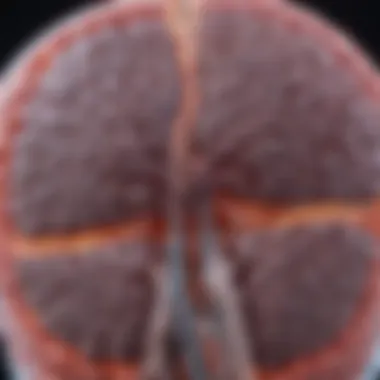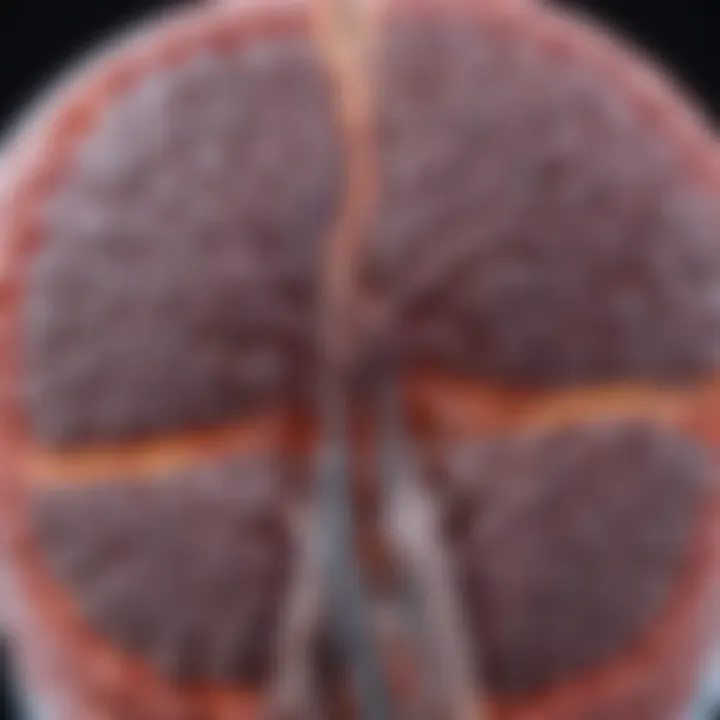Understanding Cryptogenic Stroke: An In-Depth Analysis


Intro
Cryptogenic stroke is a term used to describe a type of cerebrovascular accident that lacks a definitive cause. This medical condition presents challenges not only for the patient but also for the healthcare professionals tasked with providing care. Understanding cryptogenic stroke is crucial for the overall management and prevention of strokes, as it encompasses a range of factors often overlooked in traditional diagnostic approaches. This article will delve into various aspects surrounding cryptogenic stroke, highlighting its complexities and the recent advances in research that shed light on its diagnosis and treatment options.
Recent Advances
Latest Discoveries
Recent studies have unveiled significant insights into the mechanisms behind cryptogenic stroke. Researchers are now exploring the potential role of patent foramen ovale (PFO), a congenital heart defect, as a contributing factor. A sizable portion of patients with cryptogenic strokes have been found to exhibit this condition. Understanding how PFO may lead to stroke is pivotal in identifying intervention strategies that can help mitigate risks in susceptible populations.
Another important discovery involves the link between cryptogenic strokes and silent atrial fibrillation. Advances in cardiac monitoring technology have allowed for more effective detection of atrial fibrillation episodes that may precede a stroke. This finding can guide clinicians toward more targeted treatments and interventions that reduce the likelihood of future strokes.
Technological Innovations
Alongside latest discoveries, the field of stroke diagnostics has witnessed remarkable technological innovations. For example, the introduction of advanced imaging techniques like MRI and CT angiography has enhanced the ability to visualize brain structures and blood flow patterns. This capacity allows healthcare providers to identify subtle abnormalities that may be obscured in standard imaging. Incorporating these technologies into routine practice is essential for accurate diagnosis.
Moreover, blood biomarker studies are on the rise, opening a new frontier in understanding cryptogenic strokes. Researchers are investigating specific biomarkers that may indicate vascular risk or reveal metabolic processes associated with ischemic events. As these investigations advance, they could lead to more personalized approaches in treatment and prevention.
Finale
Understanding cryptogenic stroke involves recognizing the intricacies of its causes and the recent advances in diagnosis and treatment options available. Ongoing research will facilitate a deeper comprehension of this condition, ultimately guiding the medical community in providing better care. It is imperative that both patients and healthcare providers stay informed about this evolving topic to enhance the management of cerebrovascular incidents.
Defining Cryptogenic Stroke
Understanding cryptogenic stroke is essential in the context of cerebrovascular diseases. It presents unique challenges due to its mysterious nature, where the underlying cause remains elusive even after thorough examinations. This section aims to clarify what defines cryptogenic stroke, its implications, and why it merits attention in medical discussions and research.
Overview of Stroke Types
To appreciate cryptogenic stroke fully, it is critical to understand the spectrum of stroke types. Strokes can generally be classified into two main categories: ischemic and hemorrhagic.
- Ischemic Stroke: This type occurs when a blood vessel supplying blood to the brain is obstructed. Common causes include thrombosis and embolism. Ischemic strokes account for approximately 87% of all strokes.
- Hemorrhagic Stroke: Conversely, hemorrhagic strokes result from blood vessels that rupture, leading to bleeding in or around the brain. Factors such as high blood pressure and aneurysms frequently play a role in this type.
Cryptogenic stroke falls within the ischemic category. However, it differs by defying straightforward categorization. It is defined as an ischemic stroke without an identifiable cause despite comprehensive assessment. This complexity makes it critical for healthcare professionals to develop a rigorous understanding.
Specificity of Cryptogenic Stroke
Cryptogenic stroke specifically refers to ischemic strokes where the investigation does not reveal a clear origin. This ambiguity is significant because it affects treatment and prognostic decisions. Identifying the cause of a stroke typically guides the approach to management and prevention of future strokes. In the absence of a specific etiology, however, there are several important considerations:
- Diagnostic Challenges: Patients may undergo various tests, including neuroimaging and cardiac evaluations, but still remain classified as cryptogenic. The subtlety in pathophysiological mechanisms often compounds these challenges.
- Management Implications: The lack of an identifiable cause complicates the development of individualized treatment plans. This represents a gap in stroke prevention strategies, which can ultimately impact patient care.
- Future Research Directions: There is an ongoing need for research focused on better understanding cryptogenic strokes. Initiatives may include exploring potential unnoticed risk factors or conditions that could identify underlying causes.
In summary, defining cryptogenic stroke involves understanding both its place within the broader stroke category and its unique challenges. This foundation sets the stage for further exploration into the mechanisms, diagnostics, and management necessary for addressing this complex medical condition.
Pathophysiology of Cryptogenic Stroke
The pathophysiology of cryptogenic stroke is crucial for understanding its elusive nature. By exploring the underlying mechanisms and risk factors associated with these strokes, we shed light on a condition that often leaves both patients and healthcare providers bewildered. This section aims to elucidate these mechanisms and risk factors while considering their implications for diagnosis and treatment. Insights into pathophysiology can enhance the clinician's ability to identify potential preventive strategies and inform future research.
Underlying Mechanisms
Cryptogenic strokes are defined by their unknown etiology. Despite thorough evaluations, including imaging and laboratory tests, the cause remains undetermined. Some proposed underlying mechanisms include embolic sources, paradoxical embolism, or undetected carotid artery disease.
- Embolic Sources: In many cases, emboli may originate from the heart, specifically in patients with unknown atrial fibrillation. Small clots can travel to the brain without the patient experiencing noticeable symptoms.
- Paradoxical Embolism: Another critical mechanism is the paradoxical embolism, where blood clots bypass the pulmonary circulation through a right-to-left shunt. This shunt may be due to conditions like patent foramen ovale, leading to emboli traveling to the cerebral circulation.
- Undetected Arterial Disease: Cryptogenic strokes can also be a consequence of subtle and undiagnosed arterial disease. Small vessel disease, in which narrowing or occlusion occurs in the brain's small arteries, is often overlooked in imaging studies.


Overall, comprehending these mechanisms is vital. It directs clinical attention to further diagnostic evaluations and can inform potential interventions.
Risk Factors Associated with Cryptogenic Events
Identifying risk factors for cryptogenic strokes aids healthcare professionals in targeting preventive strategies. Various risk factors contribute to these strokes, including the following:
- Age: Older patients generally exhibit higher risk levels. This relationship highlights the need for vigilant monitoring of neurological signs in older populations.
- Hypertension: High blood pressure often leads to acceleration of vascular diseases, which can incapacitate arteries in the brain.
- Hyperlipidemia: Elevated cholesterol levels may contribute to arterial plaque formation, increasing stroke risk.
- Diabetes: This metabolic disorder adversely affects vascular health, leading to a higher likelihood of cerebrovascular incidents.
- Lifestyle Factors: Smoking and sedentary lifestyles are significant contributors. Lifestyle modification strategies can be effective in preventing strokes.
Understanding these risk factors promotes proactive risk management and reinforces the significance of lifestyle changes.
The recognition of these elements relevant to cryptogenic stroke can guide targeted therapies and lifestyle interventions. Enhanced knowledge of pathophysiological elements allows for a more personalized and effective approach in managing patients who experience these types of strokes.
Diagnostic Approaches
The diagnostic approaches to cryptogenic stroke are critical for understanding this complex condition. Recognizing the unique challenges faced by healthcare professionals in identifying the causes behind these strokes is essential. Cryptogenic strokes can often surface without any apparent reasons, necessitating a multifaceted approach to diagnosis. This section will elucidate the standard diagnostic tests, explore advanced imaging techniques, and address the challenges that often accompany the diagnostic process. Each of these aspects plays a vital role in not only confirming the diagnosis but also in shaping management strategies for patients.
Standard Diagnostic Tests
Standard diagnostic tests for cryptogenic strokes serve as the foundation for clinical evaluation. These often include a combination of patient history, neurological examination, and basic laboratory tests. The first step is a thorough medical history. It is essential to assess risk factors such as previous strokes, hypertension, diabetes, and lifestyle factors.
The most widely used initial imaging modality is a non-contrast computed tomography (CT) scan. This is vital for ruling out hemorrhagic stroke. If a stroke is confirmed, a magnetic resonance imaging (MRI) scan may be performed for better characterization of the stroke's location and extent.
Additional tests that may be performed include:
- Electrocardiogram (ECG): To identify any irregularities in heart rhythm that may contribute to stroke risk.
- Echocardiography: This test can help detect cardiac sources of embolism, such as thrombus formation in the heart.
- Blood tests: These include tests for coagulation profiles and other abnormalities such as hyperlipidemia.
Standardized protocols play a crucial role in ensuring consistency in the diagnosis, guiding better patient outcomes.
Advanced Imaging Techniques
Advanced imaging techniques expand the capability of medical professionals to diagnose cryptogenic stroke effectively. While standard imaging provides a general overview, advanced methods delve deeper into the vascular architecture and potential embolic sources.
Key advanced imaging modalities include:
- Magnetic Resonance Angiography (MRA): This technique helps visualize the blood vessels without the need for contrast agents. It can identify stenosis or occlusions that might not be visible via standard CT or MRI.
- CT Angiography (CTA): This provides a more detailed view of cerebral blood vessels, offering insights into potential sources of embolism in cases where MRA might be inconclusive.
- Transcranial Doppler Ultrasound (TCD): This non-invasive form of ultrasound assesses cerebral blood flow and can detect micro-emboli in real-time.
The higher sensitivity and specificity of these advanced techniques enable clinicians to pinpoint sources of stroke more accurately, ultimately assisting in tailoring individual treatment plans.
Challenges in Diagnosis
Despite advancements, several challenges persist in diagnosing cryptogenic strokes. One significant hurdle is the incomplete understanding of underlying mechanisms. The condition can be associated with numerous subtle pathologies that may not show up in standard tests.
Some recurring challenges include:
- False Negatives: Standard imaging may miss certain embolic sources or underlying conditions, leading to misdiagnosis.
- Temporal Factors: Symptoms like headaches or transient ischemic attacks may obscure the timing and extent of the stroke, complicating the diagnosis.
- Lack of Standardized Protocols: Variability in diagnostic practices can produce inconsistent results across different institutions.
Advances in research are necessary to confront these challenges head-on. Improved protocols and enhanced imaging modalities may lead to more definitive diagnoses in the burgeoning realm of cryptogenic strokes.
Overall, effective diagnostic approaches are a multifaceted endeavor, integrating traditional testing with advanced techniques while navigating various challenges. Understanding these elements is vital for professionals in developing effective management strategies for patients suffering from cryptogenic strokes.
Clinical Presentation


The clinical presentation of cryptogenic stroke is crucial for a comprehensive understanding of this complex medical phenomenon. Recognizing symptoms and differentiating them from other types of strokes can significantly influence the timeliness of treatment and improve outcomes. This section delves into common symptoms associated with cryptogenic stroke and the methods for distinguishing it from other stroke types.
Common Symptoms of Cryptogenic Stroke
Cryptogenic stroke can manifest through various symptoms, which are often akin to those seen in other stroke categories. Recognizing these symptoms early is essential for effective management. Common symptoms include:
- Sudden numbness or weakness in the face, arm, or leg, particularly on one side of the body.
- Confusion and difficulty speaking or understanding speech.
- Trouble seeing in one or both eyes, which may involve blurred vision or loss of vision.
- Difficulty walking, which may involve dizziness, loss of balance, or a lack of coordination.
These symptoms arise due to disrupted blood flow to specific brain regions during a stroke. However, in the case of cryptogenic stroke, causative factors remain unknown despite thorough evaluation. This uncertainty complicates the diagnosis and treatment process.
Differentiation from Other Stroke Types
Distinguishing cryptogenic stroke from other types of strokes is essential for appropriate management. Typical stroke categories include ischemic strokes, hemorrhagic strokes, and transient ischemic attacks (TIAs). Key differentiating factors include:
- History and Clinical Context: Understanding the patient's medical history is vital. Patients with pre-existing conditions such as atrial fibrillation may suggest a likely ischemic stroke.
- Diagnostic Tests: Imaging studies, like CT or MRI scans, help identify specific abnormalities in the brain. Cryptogenic stroke diagnosis often involves ruling out other stroke types and may require extensive testing.
- Duration of Symptoms: TIAs involve symptoms that resolve within 24 hours, whereas symptoms of cryptogenic strokes persist longer without a clear cause.
The identification and understanding of cryptogenic strokes hinge on both clinical symptoms and appropriate differential diagnosis, emphasizing the need for detailed evaluation.
The significance of recognizing the clinical presentation of cryptogenic strokes cannot be overstated. Patients may present with a wide range of symptoms, and ensuring accurate diagnosis is essential. It aids in tailoring specific therapeutic strategies, which ultimately impacts the patient’s recovery and future health outcomes.
Management Strategies
Management strategies for cryptogenic stroke are critical as they aim to reduce the risk of future strokes and bolster the quality of life for patients. Understanding how to approach the management of such strokes can guide healthcare practitioners in implementing effective interventions.
The complexity of cryptogenic stroke means that management must be tailored to individual patients, taking into account the various factors that contribute to their condition. Patients often experience ambiguity regarding their diagnosis, which can heighten anxiety. Therefore, having a robust management plan is essential not just for health outcomes but also for psychological reassurance.
Acute Management Protocols
Acute management protocols are vital in the immediate aftermath of a cryptogenic stroke. These protocols typically involve the initial assessment and stabilization of the patient. Here are some crucial elements:
- Immediate imaging and diagnosis: Timely neuroimaging, like MRI or CT scans, are essential. This helps to rule out other types of strokes or intracranial issues.
- Antithrombotic therapy: Depending on clinical judgment, this may include the use of aspirin or other anticoagulants to prevent further clot formation.
- Risk stratification: After the acute phase, healthcare teams must evaluate the patient's risk factors for future strokes. This may lead to further testing for conditions such as atrial fibrillation.
- Patient education: Patients must also receive education about symptoms to watch for and when to seek immediate medical attention.
Every second counts, so following structured protocols can enhance outcomes significantly. Research has shown that early intervention can lead to a more favorable prognosis.
Long-term Management and Follow-up
Long-term management of cryptogenic stroke involves ongoing evaluations and adjustments to treatment. This stage is crucial because strokes can have lasting impacts on physical and mental health. Here are some components:
- Follow-up appointments: Regular check-ups are necessary to monitor neurological health and adapt treatment plans as needed.
- Lifestyle modifications: Patients are often encouraged to adopt healthier lifestyles. This can involve dietary changes, increased physical activity, and cessation of smoking.
- Adherence to medication: Encouraging patients to stick to their prescribed regimens helps in minimizing risks of recurrence.
- Monitoring for underlying conditions: Tests may be done periodically to rule out or confirm possible causes being investigated, such as patent foramen ovale.
Overall, sustained long-term management is critical to improving outcomes for individuals who have experienced a cryptogenic stroke. The interplay of regular monitoring and lifestyle adjustments creates a holistic approach that acknowledges both physical and emotional health.
Studies show that consistent follow-up care can lead to significantly reduced recurrence rates in cryptogenic strokes.
Emerging Research and Insights
Emerging research within the field of cryptogenic stroke is vital. It opens new doors for understanding the intricacies of strokes that have no clear cause. Continuous investigations are focusing on various aspects. This includes improving diagnostic techniques and exploring new treatment avenues. The significance of these studies cannot be overstated. They enhance our knowledge and aim to address existing gaps in management.
Recent Studies on Cryptogenic Stroke
Recent studies provide a wealth of information regarding cryptogenic stroke. Researchers are delving deeper into the genetic, hemodynamic, and morphological factors that contribute to this phenomenon. For instance, some studies highlight the role of patent foramen ovale (PFO) as a potential trigger.


Key findings from recent research include:
- Genetic predisposition: Evidence suggests certain genetic markers may increase stroke risk.
- PFO prevalence: Many individuals with cryptogenic events exhibit PFO, leading to targeted investigations.
- Lifestyle factors: Smoking, hypertension, and diabetes are consistently noted as risk factors.
Understanding these elements paves the way for better risk stratification. The more precise we are at identifying potential causes, the better we can prevent future occurrences.
"Ongoing studies indicate that understanding cryptogenic stroke's etiology may eventually lead to its prevention."
Innovations in Treatment
As the research landscape evolves, so does the search for better treatment methods for cryptogenic stroke. Innovations focus on both preventive and acute management strategies. One area of interest is the use of anticoagulation therapy, particularly for patients with identified PFOs. Advances in catheter-based techniques for PFO closure have also shown promise in reducing stroke recurrence.
Notable innovations in treatment are:
- Direct oral anticoagulants (DOACs): These are being studied for their effectiveness compared to traditional anticoagulants.
- Interventional procedures: Minimally invasive techniques to close PFOs are becoming more refined, leading to improved patient outcomes.
- Monitoring technology: Wearable devices are being developed to track patients' heart rhythm, aiding in early detection of atrial fibrillation.
Ultimately, these innovations could significantly shift the current approach to managing cryptogenic strokes, making it a critical area of focus in ongoing medical research.
Prognosis and Outcomes
Prognosis and outcomes in cryptogenic stroke are crucial elements that determine both the immediate and long-term effects on patients. Understanding these factors helps in creating effective management plans and improves the quality of life for those affected. Cryptogenic strokes can lead to varying outcomes, and it is essential to closely monitor these aspects to provide appropriate care and support.
Factors Influencing Outcomes
Numerous elements influence the prognosis of a patient who has suffered a cryptogenic stroke. These factors can be grouped into clinical, demographic, and treatment-related categories.
- Age: Older age is often associated with poorer outcomes due to the presence of comorbidities and increased frailty.
- Previous Stroke History: A history of previous strokes is linked to a higher risk of subsequent events and can negatively impact recovery.
- Quality of Initial Management: Timely intervention and appropriate management protocols can significantly enhance recovery chances.
- Rehabilitation: Access to and the quality of rehabilitation services play a pivotal role in determining the long-term outcome.
In addition, the patient's resilience and support network often determine recovery trajectories. Family support and psychological factors, including motivation, can greatly affect both physical and emotional rehabilitation.
"The prognosis for individuals with cryptogenic stroke often involves multifaceted considerations that extend beyond mere medical treatment."
Long-term Effects on Quality of Life
The long-term effects of cryptogenic stroke on quality of life are profound. Many patients experience significant challenges that affect their daily activities and overall well-being. Some of these challenges include:
- Physical Disabilities: Many survivors experience motor deficits or impairments, making day-to-day tasks difficult.
- Cognitive Impairment: Cognitive function can be affected, leading to issues such as memory problems or difficulty with decision-making.
- Emotional Impact: Anxiety, depression, and frustration are common emotions that stroke survivors face, influencing their overall quality of life.
- Social Isolation: Survivors may find it harder to engage socially, which can lead to a decline in mental health and feelings of loneliness.
To mitigate these long-term effects, ongoing support is critical. Early engagement in rehabilitative therapies, including physical, occupational, and psychological support, can promote a better quality of life. Regular follow-up consultations with healthcare providers can also provide necessary adjustments to treatment plans as the patient progresses.
The End
The conclusion of an article about cryptogenic stroke is crucial for several reasons. It serves as a summarizing point that encapsulates the comprehensive details discussed throughout the text. In considering the complexities surrounding cryptogenic stroke, readers benefit from a concise recap of key elements such as diagnostics, treatment options, and emerging research. This reflection on essential topics reinforces the significance of understanding cryptogenic stroke and its implications in the medical field.
Summary of Key Points
- Cryptogenic strokes remain a challenging condition to diagnose, often eluding clear identification of the underlying cause despite thorough investigations.
- Various diagnostic techniques, including advanced imaging, are essential in the assessment process, allowing clinicians to rule out other stroke types.
- Management strategies require a dual focus on acute response and long-term follow-up, ensuring that patients receive tailored care.
- Emerging research continues to illuminate the pathways contributing to cryptogenic strokes. This may lead to better interventions in both prevention and treatment modalities.
By summarizing these core concepts, the conclusion highlights the need for increased awareness and understanding of cryptogenic strokes. This knowledge is vital for healthcare professionals, researchers, and students in the field. The complexity of the condition underscores the necessity to delve deeper into its research and management practices.
Future Directions in Research and Practice
The pursuit of understanding cryptogenic stroke is evolving steadily. Future research should focus on several critical areas:
- Identification of Novel Biomarkers: Finding specific biological markers could significantly enhance diagnostic precision. This would help distinguish cryptogenic strokes from other stroke types more effectively.
- Advancements in Imaging Technology: Continued development in imaging techniques can provide sharper images and more functional insights into underlying causes.
- Longitudinal Studies on Patient Outcomes: By tracking patients over the long term, researchers can gather valuable data on the efficacy of various management strategies and their impact on quality of life.
- Interdisciplinary Collaboration: Fostering collaboration between neurologists, cardiologists, and researchers may open new avenues for treatment and prevention strategies.
A focus on these future directions can lead to not only improved outcomes for patients but also richer knowledge within the medical community about cryptogenic stroke's multifaceted nature. The enigma of this condition necessitates sustained inquiry and innovation.















